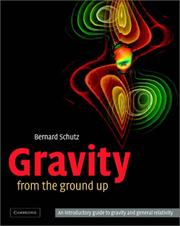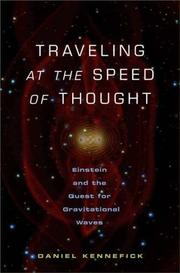| Listing 1 - 9 of 9 |
Sort by
|

ISBN: 110715717X 1139635875 9786612389443 1282389440 0511644698 0511807805 0511648693 0511336314 0511555512 0511336969 9780511648694 9780511336966 9780511251900 0511251904 9780511807800 9781282389441 0521455065 9780521455060 9781139635875 6612389443 9780511644696 9780511336317 9780511555510 Year: 2003 Publisher: Cambridge : Cambridge university press,
Abstract | Keywords | Export | Availability | Bookmark
 Loading...
Loading...Choose an application
- Reference Manager
- EndNote
- RefWorks (Direct export to RefWorks)
This book invites the reader to understand our Universe, not just marvel at it. From the clock-like motions of the planets to the catastrophic collapse of a star into a black hole, gravity controls the Universe. Gravity is central to modern physics, helping to answer the deepest questions about the nature of time, the origin of the Universe and the unification of the forces of nature. Linking key experiments and observations through careful physical reasoning, the author builds the reader's insight step-by-step from simple but profound facts about gravity on Earth to the frontiers of research. Topics covered include the nature of stars and galaxies, the mysteries of dark matter and dark energy, black holes, gravitational waves, inflation and the Big Bang. Suitable for general readers and for undergraduate courses, the treatment uses only high-school level mathematics, supplemented by optional computer programs, to explain the laws of physics governing gravity.
Gravitation. --- Gravity. --- Geophysics --- Mechanics --- Pendulum --- Field theory (Physics) --- Matter --- Physics --- Antigravity --- Centrifugal force --- Relativity (Physics) --- Properties --- Gravitation --- Gravity --- 531.5 --- 531.5 Gravity. Gravitation. Pendulums. Ballistics --- Gravity. Gravitation. Pendulums. Ballistics
Book
ISBN: 9073035090 Year: 1991 Publisher: Maastricht : Natuur en Techniek,
Abstract | Keywords | Export | Availability | Bookmark
 Loading...
Loading...Choose an application
- Reference Manager
- EndNote
- RefWorks (Direct export to RefWorks)
Theory of relativity. Unified field theory --- Geophysics --- 531.5 --- 530.12 --- #WSCH:AAS2 --- fysica --- zwaartekracht --- 531 --- getijden --- massa --- mechanica --- ruimte --- ruimtemeetkunde --- tijd --- wiskunde --- zwarte gaten --- Zwaartekracht --- Gravity. Gravitation. Pendulums. Ballistics --- Relativity principle --- Gravitatie --- Kosmologie --- relativiteitstheorie --- Kosmologie. --- relativiteitstheorie. --- 530.12 Relativity principle --- 531.5 Gravity. Gravitation. Pendulums. Ballistics

ISBN: 0521824753 051118476X 9780511184765 0511186479 9780511186479 0511187408 9780511187407 9780521824750 0511185596 9780511185595 9780511616563 0511616562 110714650X 1280457937 9786610457939 0511324162 9780521035460 Year: 2004 Publisher: Cambridge: Cambridge university press,
Abstract | Keywords | Export | Availability | Bookmark
 Loading...
Loading...Choose an application
- Reference Manager
- EndNote
- RefWorks (Direct export to RefWorks)
One appealing feature of string theory is that it provides a theory of quantum gravity. Gravity and Strings is a self-contained, pedagogical exposition of this theory, its foundations and its basic results. In Part I, the foundations are traced back to the very early special-relativistic field theories of gravity, showing how such theories lead to general relativity. Gauge theories of gravity are then discussed and used to introduce supergravity theories. In Part II, some of the most interesting solutions of general relativity and its generalizations are studied. The final Part presents and studies string theory from the effective action point of view, using the results found earlier in the book as background. This 2004 book will be useful as a reference book for graduate students and researchers, as well as a complementary textbook for courses on gravity, supergravity and string theory.
Quantum gravity --- String models --- Gravité quantique --- Modèles des cordes vibrantes (Physique nucléaire) --- Quantum gravity. --- String models. --- 531.5 --- 530.145 --- Models, String --- String theory --- Nuclear reactions --- Gravity, Quantum --- General relativity (Physics) --- Gravitation --- Quantum theory --- Gravity. Gravitation. Pendulums. Ballistics --- 530.145 Quantum theory --- 531.5 Gravity. Gravitation. Pendulums. Ballistics --- Gravité quantique --- Modèles des cordes vibrantes (Physique nucléaire)
Book
ISBN: 9780521882231 0521882230 9780511807787 9780511673559 0511673558 0511675534 9780511675539 1139637665 9781139637664 1107211166 9781107211162 1282486780 9781282486782 9786612486784 6612486783 0511807783 0511674341 9780511674341 0511672284 9780511672286 0511671008 9780511671005 Year: 2010 Publisher: Cambridge, UK: Cambridge university press,
Abstract | Keywords | Export | Availability | Bookmark
 Loading...
Loading...Choose an application
- Reference Manager
- EndNote
- RefWorks (Direct export to RefWorks)
Covering all aspects of gravitation in a contemporary style, this advanced textbook is ideal for graduate students and researchers in all areas of theoretical physics. The 'Foundation' section develops the formalism in six chapters, and uses it in the next four chapters to discuss four key applications - spherical spacetimes, black holes, gravitational waves and cosmology. The six chapters in the 'Frontier' section describe cosmological perturbation theory, quantum fields in curved spacetime, and the Hamiltonian structure of general relativity, among several other advanced topics, some of which are covered in-depth for the first time in a textbook. The modular structure of the book allows different sections to be combined to suit a variety of courses. Over 200 exercises are included to test and develop the reader's understanding. There are also over 30 projects, which help readers make the transition from the book to their own original research.
Gravitation --- Relativity (Physics) --- 531.5 --- Gravity. Gravitation. Pendulums. Ballistics --- 531.5 Gravity. Gravitation. Pendulums. Ballistics --- Nonrelativistic quantum mechanics --- Space and time --- Field theory (Physics) --- Matter --- Physics --- Antigravity --- Centrifugal force --- Properties --- Gravitation. --- Textbooks. --- Gravitation - Textbooks --- Relativity (Physics) - Textbooks --- Gravitation - Problems, exercises, etc.
Book
ISBN: 9789050410984 Publisher: Utrecht Epsilon Uitgaven
Abstract | Keywords | Export | Availability | Bookmark
 Loading...
Loading...Choose an application
- Reference Manager
- EndNote
- RefWorks (Direct export to RefWorks)
Zwaartekracht, je hebt er dagelijks mee te maken en je kunt zelfs niet zonder. Toch sta je er waarschijnlijk niet zo vaak bij stil dat bijvoorbeeld voetballen alleen door die kracht mogelijk is. Gravitatie houdt niet alleen op aarde alles netjes op zijn plaats, maar zorgt er ook voor dat onze planeet rond de zon draait en een atmosfeer heeft die leven mogelijk maakt.
Didactics of secundary education --- gravimetric analysis --- Didactics of mathematics --- wiskunde --- zwaartekracht --- gravimetrie --- 485.3 --- 51 <075> --- 531.5 --- Fysica --- Zwaartekracht --- 510 --- 103500.jpg --- 531.5 Gravity. Gravitation. Pendulums. Ballistics --- Gravity. Gravitation. Pendulums. Ballistics --- 51 <075> Mathematics--Schoolboeken --- Mathematics--Schoolboeken --- didactiek secundair onderwijs - wiskunde --- Wiskunde --- Secundair onderwijs --- Wetten van Newton --- Relativiteitstheorie --- Wet van Newton
Book
ISBN: 9780511843129 9780521871013 9781107336292 1107336295 0511843127 9781107334632 1107334632 0521871018 9781299408883 1299408885 1107326532 1107233615 1107253896 1107332974 1107335469 Year: 2013 Publisher: Cambridge : Cambridge University Press,
Abstract | Keywords | Export | Availability | Bookmark
 Loading...
Loading...Choose an application
- Reference Manager
- EndNote
- RefWorks (Direct export to RefWorks)
"This combination textbook and reference manual provides a comprehensive account of the principles, practices, and application of gravity and magnetic methods for exploring the subsurface using surface, marine, airborne, and satellite measurements. Key current topics and techniques are described, including high-resolution magnetic investigations, time-variation gravity analysis from surface and satellite gravity measurements, absolute and gradient gravimetry, and the role of GPS in mapping gravity and magnetic fields. The book also describes the physical properties of rocks and other earth materials that are critical to the effective design, implementation and interpretation of surveys, and presents a thorough overview of digital data analysis methods used to process and interpret anomalies for subsurface information. This book is an ideal text for advanced undergraduate and graduate courses, but also serves as a reference for research academics, professional geophysicists, and managers of exploration programs that include gravity and magnetic methods. It is a valuable resource for all those interested in petroleum, engineering, mineral, environmental, geological and archeological exploration of the lithosphere"--
Geomagnetism --- Gravity --- Magnetic measurements --- 531.5 --- 550.312 --- 550.3 --- Measurements, Magnetic --- Magnetics --- Gravimetry --- Earth magnetic field --- Geomagnetic field --- Magnetism, Terrestrial --- Terrestrial magnetic field --- Terrestrial magnetism --- Geophysics --- Magnetism --- 550.3 Geophysics --- 550.312 Gravity and isostasy (equilibrium theory). Distribution of specific gravity. Gravity measurement --- Gravity and isostasy (equilibrium theory). Distribution of specific gravity. Gravity measurement --- 531.5 Gravity. Gravitation. Pendulums. Ballistics --- Gravity. Gravitation. Pendulums. Ballistics --- Measurement --- Geomagnetism. --- Magnetic measurements. --- Measurement.

ISBN: 1400882745 9781400882748 0691117276 9780691117270 Year: 2007 Publisher: Princeton, N.J.
Abstract | Keywords | Export | Availability | Bookmark
 Loading...
Loading...Choose an application
- Reference Manager
- EndNote
- RefWorks (Direct export to RefWorks)
Since Einstein first described them nearly a century ago, gravitational waves have been the subject of more sustained controversy than perhaps any other phenomenon in physics. These as yet undetected fluctuations in the shape of space-time were first predicted by Einstein's general theory of relativity, but only now, at the dawn of the twenty-first century, are we on the brink of finally observing them. Daniel Kennefick's landmark book takes readers through the theoretical controversies and thorny debates that raged around the subject of gravitational waves after the publication of Einstein's theory. The previously untold story of how we arrived at a settled theory of gravitational waves includes a stellar cast from the front ranks of twentieth-century physics, including Richard Feynman, Hermann Bondi, John Wheeler, Kip Thorne, and Einstein himself, who on two occasions avowed that gravitational waves do not exist, changing his mind both times. The book derives its title from a famously skeptical comment made by Arthur Stanley Eddington in 1922--namely, that "gravitational waves propagate at the speed of thought." Kennefick uses the title metaphorically to contrast the individual brilliance of each of the physicists grappling with gravitational-wave theory against the frustratingly slow progression of the field as a whole. Accessibly written and impeccably researched, this book sheds new light on the trials and conflicts that have led to the extraordinary position in which we find ourselves today--poised to bring the story of gravitational waves full circle by directly confirming their existence for the very first time.
Space and time. --- General relativity (Physics) --- Einstein field equations. --- Gravitational waves. --- Space of more than three dimensions --- Space-time --- Space-time continuum --- Space-times --- Spacetime --- Time and space --- Fourth dimension --- Infinite --- Metaphysics --- Philosophy --- Space sciences --- Time --- Beginning --- Hyperspace --- Relativity (Physics) --- Relativistic theory of gravitation --- Relativity theory, General --- Gravitation --- Physics --- Einstein's field equations --- Einstein's gravitational field equations --- Einstein's law of gravitation --- Field equations, Einstein --- Differential equations --- Field theory (Physics) --- Gravitational fields --- Gravitational radiation --- Gravity waves (Astrophysics) --- Radiation --- Waves --- Einstein field equations --- Gravitational waves --- Space and time --- 531.5 --- 531.5 Gravity. Gravitation. Pendulums. Ballistics --- Gravity. Gravitation. Pendulums. Ballistics
Book
ISBN: 3319749595 3319749587 Year: 2018 Publisher: Cham : Springer International Publishing : Imprint: Springer,
Abstract | Keywords | Export | Availability | Bookmark
 Loading...
Loading...Choose an application
- Reference Manager
- EndNote
- RefWorks (Direct export to RefWorks)
The author of this history of mankind’s increasingly successful attempts to understand, to measure and to map the Earth’s gravity field (commonly known as ‘little g’ or just ‘g’) has been following in the footsteps of the pioneers, intermittently and with a variety of objectives, for more than fifty years. It is a story that begins with Galileo’s early experiments with pendulums and falling bodies, progresses through the conflicts between Hooke and Newton and culminates in the measurements that are now being made from aircraft and satellites. The spectacular increases in accuracy that have been achieved during this period provide the context, but the main focus is on the people, many of whom were notable eccentrics. Also covered are the reasons WHY these people thought their measurements would be useful, with emphasis in the later chapters on the place of ‘g’ in today’s applied geology, and on the ways in which it is providing new and spectacular visions of our planet. It is also, in part, a personal memoir that explores the parallels between the way fieldwork is being done now and the difficulties that accompanied its execution in the past. Selected topics in the mathematics of ‘g’ are discussed in a series of short Codas.
Gravity --- Measurement. --- Popular works. --- History. --- Geophysics. --- Earth. --- Geology. --- Popular Science. --- Popular Earth Science. --- Geophysics/Geodesy. --- History of Science. --- Gravimetry --- Physical geography. --- Annals --- Auxiliary sciences of history --- Geography --- Geological physics --- Terrestrial physics --- Earth sciences --- Physics --- Geognosy --- Geoscience --- Natural history --- Double pendulums --- Pendulum --- Measurement --- Bouguer, --- Brahe, Tycho, --- Galilei, Galileo, --- Hooke, Robert, --- Kepler, Johannes, --- Newton, Isaac,
Book
Year: 2021 Publisher: Basel, Switzerland MDPI - Multidisciplinary Digital Publishing Institute
Abstract | Keywords | Export | Availability | Bookmark
 Loading...
Loading...Choose an application
- Reference Manager
- EndNote
- RefWorks (Direct export to RefWorks)
This book is devoted to the teaching and learning of fluid mechanics. Fluid mechanics occupies a privileged position in the sciences; it is taught in various science departments including physics, mathematics, mechanical, chemical and civil engineering and environmental sciences, each highlighting a different aspect or interpretation of the foundation and applications of fluids. While scholarship in fluid mechanics is vast, expanding into the areas of experimental, theoretical and computational fluid mechanics, there is little discussion among scientists about the different possible ways of teaching this subject. We think there is much to be learned, for teachers and students alike, from an interdisciplinary dialogue about fluids. This volume therefore highlights articles which have bearing on the pedagogical aspects of fluid mechanics at the undergraduate and graduate level.
fluid dynamics education --- damped pendulums --- fluid drag --- fluid-structure interaction --- computational fluid dynamics --- outcomes competences --- hydraulic engineering --- hydraulic teaching --- active methodology --- droplet impact --- undergraduate education --- applications of fluids --- vortex formation length --- wake --- vortex shedding --- practical engineering education --- fluid mechanics --- learning and teaching --- laboratories --- data assimilation --- variational and sequential methods --- Kalman filtering --- forward sensitivity --- measurements fusion --- reduced order models --- quasi-geostrophic equations --- closure models --- Navier-Stokes equations --- Leray-Hopf weak solutions --- existence --- inquiry-based instruction --- science education --- teaching-learning sequences --- didactic transformation --- primary level --- CFD --- Julia --- Blasius --- Hiemenz --- Homann --- Falkner–Skan --- boundary-layer --- open water tank --- education --- n/a --- Falkner-Skan
| Listing 1 - 9 of 9 |
Sort by
|

 Search
Search Feedback
Feedback About UniCat
About UniCat  Help
Help News
News